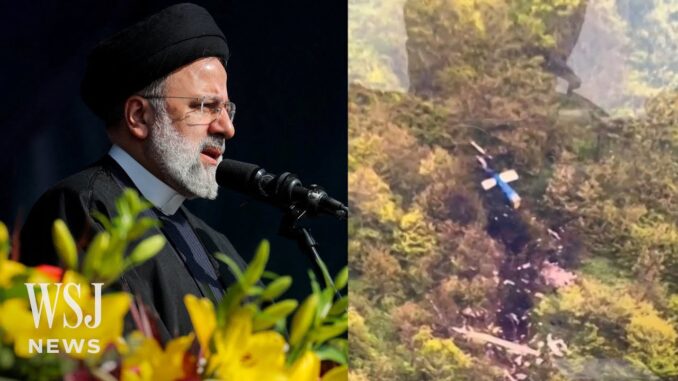E. Rowell: From Amir Tsarfati’s Telegram channel on 20/5: “Intellitimes blog reveals that Iran fitted President Raisi with a government helicopter based on a military Bell 412EP equipped with 4 rotors, depending on the size and number of passengers in this version, but on the day of the crash it was observed with only two rotors, similar to the Bell 212, indicating a change which was made in a helicopter possibly because of shortage of original parts or a poorly made upgrade. This means that the helicopter that was originally designed to carry 10 passengers using a propulsion force created by 4 rotors took off that morning, with 9 passengers, with propulsion power from only 2 rotors and in weather and wind conditions that did not match its original design.”
By David Israel, JEWISH PRESS 26 May 2024
 Raisi’s crashed helicopter, May 20, 2024./YouTube screenshot
Raisi’s crashed helicopter, May 20, 2024./YouTube screenshot
The Telegraph Defense and Foreign Affairs Editor Con Coughlin, on Sunday, reported that “The rotten Iranian regime is on the edge of collapse,” and suggested that “Instead of appeasing its leaders, the West should be helping to bring about its downfall.”
Iran’s leadership places blame for the helicopter crash that claimed the lives of President Raisi, the foreign minister, and six others not on any failings in aircraft operations or maintenance, but on the West and its sanctions, notes Coughlin. These economic restrictions, they argue, have cruelly denied Tehran the ability to procure the necessary aviation parts to properly maintain the US-made Bell 212 helicopter in which the Iranian president met his untimely demise. This deflection of responsibility reveals the warped perspective through which Iran’s rulers view such catastrophic events.
“It’s hard not to see the death of Iranian president Ebrahim Raisi in a helicopter crash last week as a reflection of the Islamic Republic’s institutional decrepitude. As is generally the case when the mullahs find themselves under pressure, their default position is to blame the West,” Coughlin writes.
And so, as Supreme Leader Ayatollah Ali Khamenei’s portrayal of “business as usual” rings increasingly hollow, the regime’s glaring inability to ensure even the basic security of its highest elected official lays bare the stark reality facing Iranians, rapidly solidifying the perception of a government in terminal decline.
The mullahs’ faltering grip on power is becoming more apparent with each such incident that exposes their diminishing control and competence. As this pivotal event casts further doubt on the regime’s viability, the Iranian people’s eroding confidence in their leaders’ capacity to govern effectively only intensifies.
The regime’s fundamental fragility has not escaped the notice of ordinary Iranians, who have increasingly voiced their discontent through widespread protests, argues Coughlin. Denied a legitimate avenue to register their contempt for the leadership at the ballot box, the citizens have sustained a constant wave of anti-government demonstrations, braving the wrath of Iranian security forces. The regime’s desperation to suppress this simmering unrest is palpable, as executions have soared to record levels. Protesters, bloggers, and notable dissidents face death sentences under the catchall charge of “enmity against God” – a measure of the extremes to which the authorities will go to quell dissent.
The people’s defiance, undeterred by the brutal crackdowns, underscores the depths of their disillusionment with the ruling establishment. Despite the risks, Iranians continue to take to the streets, their relentless demonstrations a resounding rejection of the regime’s legitimacy and an expression of their unwavering demand for change. As the chasm between the populace and their leaders widens, the regime’s tenuous grip on power is laid bare, fueling escalating unrest that poses an existential threat to the once-formidable revolutionary government.
Coughlin concludes: “Rather than virtue-signaling their remorse, as the UN Security Council did by observing a moment of silence in honor of one of Iran’s most notorious killers, the West should be doing its level best to highlight the fact the regime’s days are numbered.”




@Raphael
https://www.washingtonexaminer.com/restoring-america/courage-strength-optimism/3010018/raisis-death-wont-change-much-for-iran/
We hear this all the time…Iran’s on the verge of collapse. Jordan is on the brink of collapse. Egypt is on the edge of collapse. On and on. Don’t believe any of it until it happens. The way things go, Raisi is likely to be replaced with someone just as bad, only it will take time to figure out his MO, who are his right hand men, and what is his agenda. Isn’t there an old saying about the devil you know being better than the one you don’t know?
Edgar
More I think. The thing which keeps the Mullahs in power is actually the divisive nature of the opposition which is highly fractured. From the royalists to the communists to the republicans and various other factions, the opposition is as opposed to each other as it is to the Mullahs whom they all oppose. The Mullahs manipulate the antagonism among these groups quite effectively, and so despite significant opportunities which have arisen over the years, as Sebastien suggests, the Mullahs have repeatedly earned bragging rights to state that “The reports of my death are greatly exaggerated”.
There has been a recent report of the opposition consolidating support, and hopefully this is more than mere hopium, but time will tell.
Dictionary.com
How many times has “Iran’s regime is on the verge of collapse” been declared. 5-6-7 or more??
Count on the US Adm to protect the genocidal regime.
It has already instructed the EU not to censure Iran nuclear program!